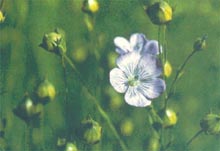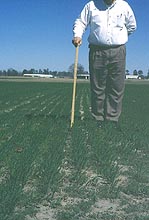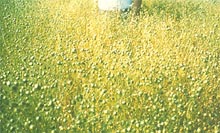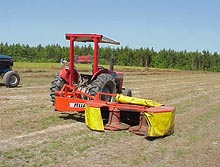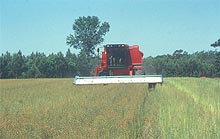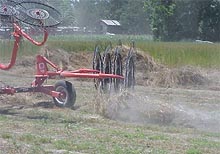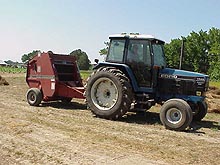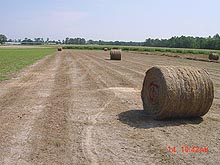Flax fiber Farming Practices in the Southeaster United States
| Flax fiber | Textile fiber Research | Education Main Page | Message Boards | News |
|
Jonn A. Foulk, Cotton Quality Research Station, USDA-ARS, Clemson, SC, Danny E. Akin, R. B. Russell Agricultural Research Center, USDA-ARS, Athens, GA, Roy B. Dodd, Department of Agricultural and Biological Engineering, Clemson University, Clemson, SC Corresponding author: Jonn A. Foulk. jonnf@clemson.edu Foulk, J. A., Akin, D, E., Dodd, R. B. 2003. fiber flax farming practices in the southeastern United States. Online. Crop Management doi:10.1094/cM-2003-0124-01-MG. Abstract Flax fiber and oilseed use is increasing in textiles, composites, paper/pulp and industrial/nutritional oil sectors in the U.S. As a winter crop, flax fits well into double-cropping systems in the southeastern U.S. Flax can be harvested as an early crop for fiber, with attached immature seeds, or harvested as a late, mature crop, for both seed and fiber production. Flax can be grown and harvested for fiber using equipment that is readily available and well understood by U.S. farmers. Overview Flax is an agricultural crop that can provide food (14), fuel (2), and fiber (22). Worldwide, flax is grown on 12 million acres (12). In 2001, according to tariff and trade data from the U.S. Department of Commerce, the U.S. imported flax and linen (fiber, yarn, fabric and clothing) with a customs value of more than 39 million dollars. Globally, the U.S. is the largest per capita consumer of flax fiber and all of the industrial grade fiber is imported. Over the years, fiber and seed flax (Linum usitatissimum L.) have been grown successfully across a large region of the U.S. (12,23,20). Compared to flax grown for seed, fiber flax plants are taller, have fewer branches, produce more fiber, have a lower oilseed content and produce less seed (1). Flax fiber has customarily been divided into two classes, namely long-line fiber and tow. Tow is a byproduct of long-line fiber production and consists of short staple fibers. Short staple spinning units dominate North American textile mills; no long-line flax fiber processing facilities are operating in the U.S. Fall flax production in the southeastern U.S. has the potential to enhance rural economic growth and to supply a domestic source of fiber to industries. Kingstree, South Carolina, is the location of a newly organized flax fiber processing company, which currently depends on local farmers to produce flax on approximately 1200 acres to supply fiber for its commercial processing plant. North Carolina and New Jersey are home to two different paper-manufacturing facilities that utilize approximately 275,575 tons of refined Canadian flax fiber per year (6). An automobile composites company located in Canandaigua, New York, uses approximately 750 tons of refined Canadian fiber each year. Many individuals, companies, and agricultural experimental stations have attempted to grow flax in the southeastern U.S. during the summer. Often, flax stands established well but died with the arrival of hot and dry weather (20). fiber flax grown during the summer in the southeast was of inferior quality with low yields. In contrast, Foulk et al. (8), Frederick (2000, unpublished data), Loadholt (11), and Parks et al. (16) established that flax could be grown as a winter crop in the southeastern U.S. with stalk yields around 6,000 lb/acre. fiber flax can be produced in the southeastern U.S. using the new production system designated Clemson fiber Flax (CFF). CFF is a system that optimizes flax fiber yield and quality by identifying field preparation, planting date, and harvest techniques that producers in the southeastern U.S. can readily adopt. Flax Plant Characteristics fiber flax is an annual plant that grows for 90 to 180 days to a height of around 48 inches when sown in high density (16). Disease-resistant varieties of flax perform best during cool and moist weather on fertile silt to clay loams with proper crop rotation (10). The long strong bast fibers for further processing are found between the bark and core (23). The plant produces a stem approximately 0.04 to 0.08 inches at the base with 80 to 100 leaves and 5 light-blue, white, or pink petals (Fig. 1) (23). Flax produces seed capsules containing 10 seeds and is primarily self-pollinated with some pollination due to insects (15). The root system contains no bast fiber (18). The root system of flax is less extensive than many other crops, and therefore it is less competitive for moisture (10). Newer flax varieties demonstrate increased yields of straw, fiber, and seed as well as greater resistance to diseases and lodging compared to older varieties.
|
|
Planting and Protection
The southeastern U.S. has a long growing season and mild winters which allow growers to potentially produce a winter crop of flax (4). The CFF production system involves precise seedbed preparation for planting. Flax seedlings have difficulty emerging from crusted soils and are sensitive to hot and dry conditions during growth. A good seedbed includes weed control, conservation of soil moisture and a flat (few large clods), uniform, and firm seedbed for germination (Fig. 2). In addition, since the plants will be mowed using a drum mower, a flat and even field provides the greatest harvest efficiency (resulting in less stubble) as plants are uniformly cut at the soil's surface. The seedbed can be prepared using a disc harrow and field cultivator or any other combination producing a flat and uniform field. Seeds should be broadcast or drill planted with a row spacing of roughly 7 inches and approximately 0.4 inches deep with the depth never to exceed 1 inch. fiber flax varieties are planted closer together than seed flax varieties so that only the main stem develops and the plants grow tall with fewer branches and seeds, thus producing long, fine, and strong fibers. Parks et al. (16) reported that 110 lb seeds per acre is the desired seeding rate for fiber flax. Flax tolerates a wide range of soil types but does best on fertile, well-drained, medium to heavy textured soils (10). Well-drained loamy or silty soils are desirable for planting with subsoil clay or B-horizon within 12 inches of the surface more desirable (16). Before planting, the soil pH should be between 5.8 and 6.5. In the absence of direct recommendations for flax, the fertilizer rates suggested for production of small grains can be followed. According to Frederick (2000, unpublished data), a general target for nitrogen, phosphorous, and potassium in the soil would be 70, 60, and 150 lb/acre. Loadholt (11) evaluated the influence of nitrogen, phosphorus, potassium, and micronutrients on poor and well-drained coastal plain soils. Management of nitrogen is critical with a total of 70 to 80 lb of nitrogen per acre for residual and added nitrogen necessary (1,12,16,23). Nitrogen should not be placed next to the seed (1), and excessive nitrogen should be avoided as it encourages weed growth and lodging without enhancing fiber production. Flax plants are sensitive to zinc deficiency (16,23); however, micronutrient fertilization is seldom recommended (1). The growing practices for fiber and seed
flax are comparable (13), which allows use of flaxseed
herbicide (3,9,12), pesticide (1,3,9,12), fertilizer
(1,3,9,12,17,24), and insecticide recommendations
(1,3,9,12). Flax seedlings do not compete well with other
plants, and yield and quality are improved with weed
control. Herbicides on seed flax are superior to post-plant
tillage techniques in controlling weeds in flax (5). The
herbicides Treflan or Treflan EC are used prior to
planting with post-emergence herbicides such as Buctril,
MCPA Depending upon the location within the southeastern U.S., seeds planted between October and December benefit from the cool and moist weather. Flax benefits from this cool and wet weather since the plant requires adequate soil moisture from planting until flowering. Flax grows well with frequent, low volume irrigation (10). To benefit from weather conditions planting should be done as early as possible; crops grown in portions of Arizona, California, and Mexico are planted from November through December (7). Temperatures below 28F can kill flax in the seedling stage so flax is planted along the coast in South Carolina, Georgia, and Louisiana between October 15 and November 10. In some instances, temperatures below 15F have killed fiber flax plants, with these deaths typically related to the time that plants are exposed to these temperatures. Flax grown in Texas is sown from late November through early December. For locations further north such as Virginia and Tennessee, flax is planted in March (20). Harvesting and Retting Flax roots do not contain fiber so it is not
necessary to harvest the entire plant. The time of harvest
is influenced by climatic conditions and the crop's final
use (Fig. 3). Harvesting of flax at different maturities
according to the CFF process provides a diversity of
products: (i) early crop for fiber only, with attached
immature seeds for greater fiber quality, or (ii) mature
crop for both seed and fiber production (19). The finest
fibers are obtained by harvesting the crop following a full
bloom with the stem and leaves green or at medium fiber
fineness when half to a third of the seed bolls are yellow
and brown with fully-developed seeds (19). According to the
CFF process, flax is cut with a drum mower (Fig. 4). When
harvesting with a drum mower, changes such as mower blade
angle and tractor speed relative to the greenness of plants,
as well as operator skill, field preparation, planting, and
harvesting techniques affect the height of the flax left in
the field as stubble.
Flax that has been naturally dried or sprayed with a desiccant produces a dry, usable seed. To harvest flax for seed requires relatively dry stalk material; otherwise stalks clog the stripper header of the combine. Harvesting flax at maturity according to the CFF process requires that the seeds be first removed from stalks with a stripper header attached to a grain combine (Fig. 5). In combining, seeds are easily damaged so the condition of the seed determines the harvesting speed. Flaxseed can be safely stored at moisture levels of 10.5% or lower (3). The deseeded stalks are then drum-cut, field-dried, and raked (Fig. 6) for even dew-retting and drying. Flax straw should be raked into windrows and baled using standard hay baling protocol such as straw dryness, baler setting, bale density, speed, and packaging.
The fine bast fibers are released from the stem by a process termed dew-retting. Mowed flax is dew-retted according to weather conditions and completed in a week (when weather is warm and moist) to months (when weather is cold and dry) (18). In this process, indigenous fungi and bacteria partially decompose the plant stems of flax. These organisms produce enzymes capable of degrading the non-fibrous tissues in flax stems with an influence on the quality of the fiber. Through enzymes, the selective biodegradation of the pectinaceous and matrix substances facilitates the removal of cellulose fibers from the woody portion of a flax plant (21). Due to weather conditions, dew-retting is uncertain and so it is important to form a uniform layer of mowed flax stalks and, if possible, rake the crop for consistent retting. Flax stalks can be over-retted, which produces fibers of substandard strength due to the decomposition of the cellulose fibers. Many variables, including temperature, moisture, organisms, mowed straw layers, and raking, influence retting and so the stems must be inspected periodically for harvest optimization. Higher temperatures and moisture increase the activity of microorganisms that degrade the pectin while non-uniform straw layers created during raking can create varying zones of retting. Dew-retting is subjectively judged and considered complete once the fibers appear silver and separate easily from the stem. Following dew-retting, the fibers are then dried for baling and further processing (Fig. 7). According to the CFF process, flax can be baled using a round or square hay baler (Fig. 8) for fiber processing.
Summary As with any crop, intelligent farming is required to produce high quality and profitable flax. Flax production costs parallel other small grain production crops in the southeastern U.S., indicating it may be a supplementary crop for idle lands. No costly, specialized harvesting equipment is required using the CFF system. Research shows that high-quality, short-staple fibers are found in early-harvested flax and from mature flax harvested for seed and fiber. The CFF system in conjunction with new processing methods allow the production of a domestic, commercial source of flax fiber for textile, composite, and paper industries. Flax as a winter crop for fiber, especially in double-cropping with high value summer crops, has the potential to enhance the income of local industries in the southeastern U.S. Acknowledgements Mention of specific products is for information purposes only and is not to the exclusion of others that may be suitable. The contributions of James Frederick to this work are gratefully acknowledged and appreciated. Literature Cited 1. Anonymous. 1992. Growing Flax. Flax Council of Canada. Winnipeg, Manitoba. 2. Anonymous. 1995. Using straw as a farm heating fuel. Online. PAMI Research Update Pamphlet 719. Prairie Agricultural Machinery Institute. Saskatchewan, Canada. www.pami.ca/pDFs/pami719.pdf 3. Anonymous. 2002. Flax crop production. Online. The Flax Council of Canada. Winnipeg, Manitoba. http://www.flaxcouncil.ca/crpindex.htm 4. Bauer, P., and Frederick, J. 1997. Winter crop effect on double-cropped cotton grown with and without irrigation. Pages 220-222 in: Proc. of the 20th Ann. Southern Conservation Tillage Conf. for Sustainable Agric, June 24-26, 1997. R. N. Gallaher and R. McSorley, eds. University of Florida Special Series SS-AGR-60. 5. Carr, P., Martin, G., and Harris, J. 1997. Postplant tillage provides limited weed control in flax, lentil, and spring wheat. Online. North Dakota State University, North Dakota Agricultural Research. Fall 1997. Fargo, ND. http://www.ag.ndsu.nodak.edu/ndagres/ndagres.htm 6. Domier, K., and Kerr, N. 2000. The potential for agricultural fibres. Pages 138-140 in: Proc. of the 58th Flax Institute of the United States. March 23-25, 2000, Fargo, ND. 7. Dybing, C., and Lay, C. 1981. Flax: Linum usitatissimum cultural practices, chemical composition of flaxseed and linseed meal. CRC Biosolar Resource. CRC Press. 2:71-85. 8. Foulk, J., Dodd, R., and Akin, D. 2000. New low cost flax fibers for composites. Paper No. 2000-01-1133. Society of Automobile Engineers. 9. Gregoire, T. 2002. ProCrop 2002: Flax Menu. Online. NDSU Crop Production Information, North Dakota State University, NDSU Extension Service. Fargo, ND. www.ag.ndsu.nodak.edu/aginfo/procrop/flx/index.htm 10. Hocking, P., Randall, P., and Pinkerton, A. 1987. Mineral nutrition of linseed and fiber flax. Adv. Agron. 41:221-296. 11. Loadholt, C. 1965. The Influence of Nitrogen, Phosphorus, Potassium and Micronutrients on the Yield and Quality of fiber Flax on Two South Carolina Coastal Plain Soils. M.S. thesis. Clemson University, Clemson, SC.. 12. Myers, R. 2000. Flax: A crop from America's past with renewed potential. Online. Thomas Jefferson Agricultural Institute, Crop Production Guides. Columbia, MO. 13. Oelke, E., Johnson, S., Ehrhardt, P., and Comstock, V. 1987. From flax straw to linen fiber. Minnesota Extension Service Fact Sheet AG-FS-3339. 14. Oomah, D. 2001. Flaxseed as a functional food source. J. Sci. Agric. 81:889-894. 16. Parks, C., Frederick, J., Porter, P., and Murdock, E. 1993. Growing Flax in South Carolina. Clemson University Cooperative Extension Service, Clemson, SC. 17. Penney, D. 2002. Alberta fertilizer guide. Online. Alberta Agriculture Food and Rural Development Agdex 541-1. 18. Robinson, B. 1934. Flax-fiber Production. Farmers Bull. No. 1728. USDA. Washington, DC. 19. Robinson, B., and Hutcheson, T. 1931. The Time to Harvest fiber Flax. Circ. 236. USDA. Washington, DC. 20. Robinson, B., and Hutcheson, T. 1932. Adaptation of fiber Flax to South Atlantic States. Circ. 231. USDA. Washington, DC. 21. Sharma, H., and Van Sumere, C. 1992. The Biology and Processing of Flax. M Publications. Belfast, Northern Ireland. 22. Smeder, B., and Liljedahl, S. 1996. Market oriented identification of important properties in developing flax fibres for technical uses. Indust. Crops Products. 5:149-162. 23. Stephens, G. 1997. A manual for fiber flax production. The Connecticut Agricultural Experiment Station, New Haven, CT. 24. Sultana, C. 2002. Flax: World Fertilizer Use Manual. Online. International Fertilizer Industry Assoc. (IFA). Paris, France. |
|
Article Source Information: 2003. Plant Management Network. This article is in the public domain. Accepted for publication 30 December 2002. Published 24 January 2003. Article retrieved by Apparel Search on April 8th, 2007 from plantmanagementnetwork.org/pub/cm/management/2003/flax/ |
Apparel Search
Add Your Company
Contact
Us About Us
Advertise
News Letter
Legal
Help
Copyright © 1999-2023 Apparel Search Company. All Rights Reserved.
